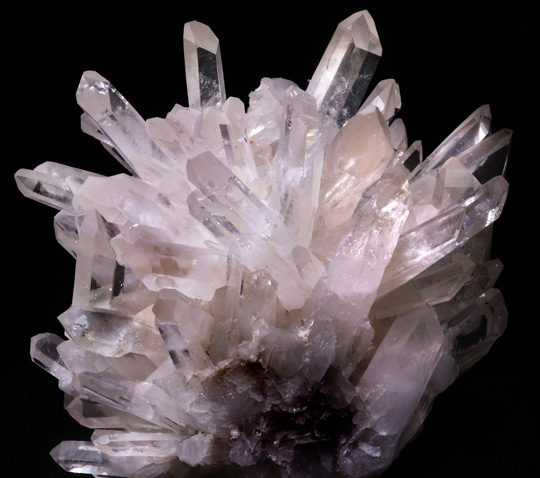Quartz
Quartz is one of the most abundant minerals in the Earth's crust, second only to feldspar, and its occurence is very widespread. Its chemical formula is silicon dioxide: SiO2.

Quartz
Photo by JJ Harrison - lic. under Creative Commons 2.5
The quartz "family" of gemstones includes many other named stones: As well as the clear type of "pure" or regular quartz such as in the picture above, quartz can also occur as smoky quartz, rose quartz, citrine, amethyst, tiger's eye, aventurine, rutilated quartz, chalcedony, ametrine (a hybrid with both amethyst and citrine) and more. It is various mineral impurities that create the different colors seen in the colored varieties. [1]
Another interesting variety is tourmalinated quartz - this is formed when needles of black tourmaline have grown through the quartz as it was developing.
Quartz can be found in many possible forms, including crystalline (as seen in the image), cryptocrystalline or microcrystalline (composed of crystals too small to be distinguished with the naked eye), stalactitic, massive (an irregular mass), or as drusy (also known as druze, druse, druzy) - a "carpet" of very small, yet distinguishable crystals, often on the inner surface of a geode. [1]
Quartz History
As can be imagined for such a commonly-occuring and often attractive looking stone, quartz has a long history of use and a perennial popularity. It has been found in ancient burial sites, and was used for primitive tools. In Old Europe, quartz was called "rock crystal" and was carved into vases, engraved gems and other decorative objects. Roman naturalist Gaius Plinius Secundus (23 - 79 AD), better known as Pliny the Elder, held the belief that quartz was actually ice which had become "permanent" after being frozen for long periods of time. This idea seems to have been prevalent in old times, for the Greek word "crystallos" means "ice", suggesting that "rock crystal" was once thought of as "rock ice". Pliny's theory as to the origin of quartz was supported by its physical resemblance to ice, and by the observation that quartz had been found on glaciers but not on volcanoes. [1] [2]
One interesting quality of quartz is that the "long" faces are always at 60 degrees to each other. This was discovered by pioneering Danish researcher and scientist Nicholas Steno (1638-1686), who discovered that angles between corresponding faces on a crystal are the same in all examples of the same mineral. This breakthrough could be considered the beginning of modern crystallography and is known as Steno's law of constant angles. [1] [3]
Quartz has been found to be piezoelectric. This means that when the crystal is put under mechanical pressure, it develops an electric charge. This quality has a number of useful applications including the creation of ignition sources, microbalances and electronic frequency generators. Quartz's piezoelectric effect was first demonstrated (along with the piezoelectric effect of a handful of other crystal types, including tourmaline) in 1880 by the Curie brothers. In 1910, 20 classes of crystals that demonstrated the piezoelectric effect were described by Woldemar Voigt in a crystal textbook called Lehrbuch der Kristallphysik. [1] [4]
In addition to quartz (and its many sub-varieties), there are no fewer than eight other known minerals composed of silicon dioxide. These nine are known as the quartz group and are named coesite, crystobalite, beta crystobalite, keatite, quartz, beta quartz, stishovite, tridymite and beta tridymite. In addition to these, opal and the rare lechatelierite are sometimes considered to be part of this group - as they also predominantly contain SiO2. However, opal and lechatelierite are amorphous mineraloids (lacking a crystal structure) and have other properties which set them apart from the other members of the quartz group. [5]

Quartz
Photo by Didier Descouens - released under CCA 3.0 Unported License
Quartz - Sources Referenced:
[1] http://en.wikipedia.org/wiki/Quartz
[2] http://www.gemstone.org/gem-by-gem/english/quartz.html
[3] http://en.wikipedia.org/wiki/Nicolas_Steno
[4] http://en.wikipedia.org/wiki/Piezoelectricity
[5] http://www.galleries.com/minerals/silicate/quartz.htm
Back to the Gemstones List home page - over 160 gemstones explored!
Please feel free to link to this page - copy / paste the text below: (click to select)
Privacy Policy | Cookie Policy | GDPR | About This Site / Terms

© gemstoneslist.com


